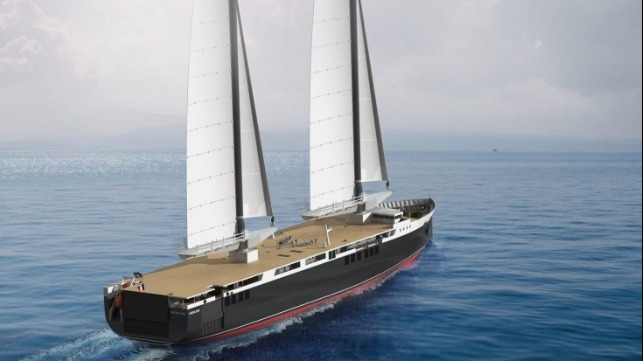Construction Contract for First Sail Ro-Ro Neoliner is Completed

The construction contract for the world’s first, large wind-powered modern commercial cargo ship has gone effective marking a key milestone in a project launched more than a decade ago. With the completion of financing, including investments from the CMA CGM Fund of Energies and Corsica Ferries, Neoline Armateur and RMK Marine shipbuilding of Turkey reported the contract went into force on January 6, 2023, and calls for the delivery of the Neoliner in 2025.
“Here we are, the first Neloner will come to life,” said Jean Zanuttini, CEO of Neoline calling it the first achievement of a more than 10-year project. “Together, we have succeeded in carrying out a project which, in many respects, could initially seem utopian. This is an unprecedented opportunity to do our part in the energy transition and to pick up the thread of history of maritime transport under sail.”
The 446-foot long Neoliner is a Ro-Ro cargo vessel that will primarily be propelled by two 250-foot high solid sails that provide over 32,000 square feet of sail area. It will be the first installation of the SolidSail rigging system created by Chantiers de l’Atlantique. The French shipyard will develop the sail system for the vessel which consists of carbon fiber masts and a unique base that both permits the sails to rotate and to till to increase the vessel’s clearance. The sails are expected to reduce emissions from operation by 80 to 90 percent versus conventional vessels.
For port maneuvers and to maintain the schedule, Neoline says the vessel’s wind propulsion will be supplemented with an auxiliary engine and MGO (Marine Gasoil) desulfurized generators as well as three transverse thrusters. Each exhaust will be equipped with Selective Catalytic Reduction scrubbers to suppress NOx emissions.
The load capacity of the vessel will be 1,200 linear meters, or 265 TEU, for a maximum weight of 5,300 tons of goods. This shipyard equates that to a capacity of 321 cars. Equipped with a ramp, the vessel is designed to transport cars or other rolling equipment as well as containers and general cargo. French companies, such as Renault Group, Beneteau Group, Manitou Group, Michelin, Jas Hennessy & Co., Clarins, Longchamp, or Rémy Cointreau, are among the first customers for the new operation between France and North America.
The normal crew complement will be 13 people, although it can be increased to 20 to embark trainees and technicians. The Neoliner will also have accommodations for 12 passengers in six double cabins.
In addition to the sails, the vessel incorporates sophisticated technology. A sensor system will aid in determining the optimal navigation route. Neoline has announced that the pilot transatlantic route will sail between Saint-Nazaire, France, Saint-Pierre-et-Miquelon, Halifax, Canada, and Baltimore in the United States. They anticipate monthly departures starting in 2025.
The Letter of Intent for the construction was executed on July 5, 2022, after an international tender for the construction, and the contract was signed in November 2022. Neoline Armateur reported last week that it had completed the construction financing with co-financing from CMA CGM, ADEME Investissement, NEOLINE Développement, Corsica Ferries, Louis Hardy S.A.S, the Banque des Territoires and the Pays de la Loire Region. The share of bank financing is provided by the Crédit Industriel et Commercial (CIC) and guaranteed by the Public Bank of Investment (BPI).
RMK will oversee the construction project. Partners contributing to the design and construction will include Chantiers De l'Atlantique shipyard, the designer and manufacturer of the Solidsail Rig System, designers Bureau Mauric, D-Ice for the special navigation system for a sail-powered ship, and other solution partners. Neoline reports the construction budget is more than €60 million.
Neoline notes that the first sketches for the sailing vessel were developed in 2011. Through the construction and commissioning of this first Neoliner, the company says its foremost objective is to demonstrate under real operational conditions the potential of main propulsion by the wind for commercial shipping. They plan to encourage the creation of an entire fleet powered by the force of the wind as its main propulsion.
